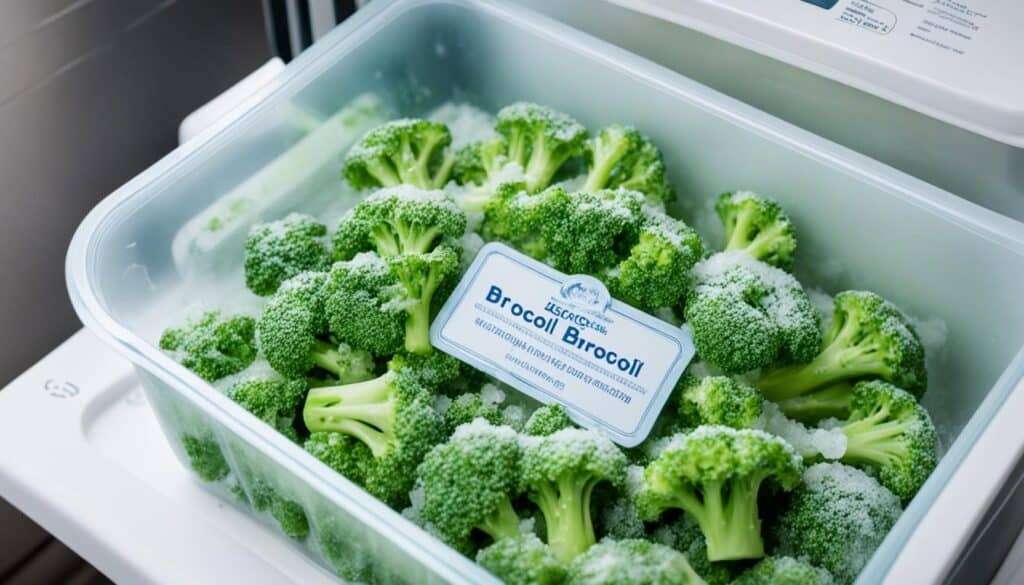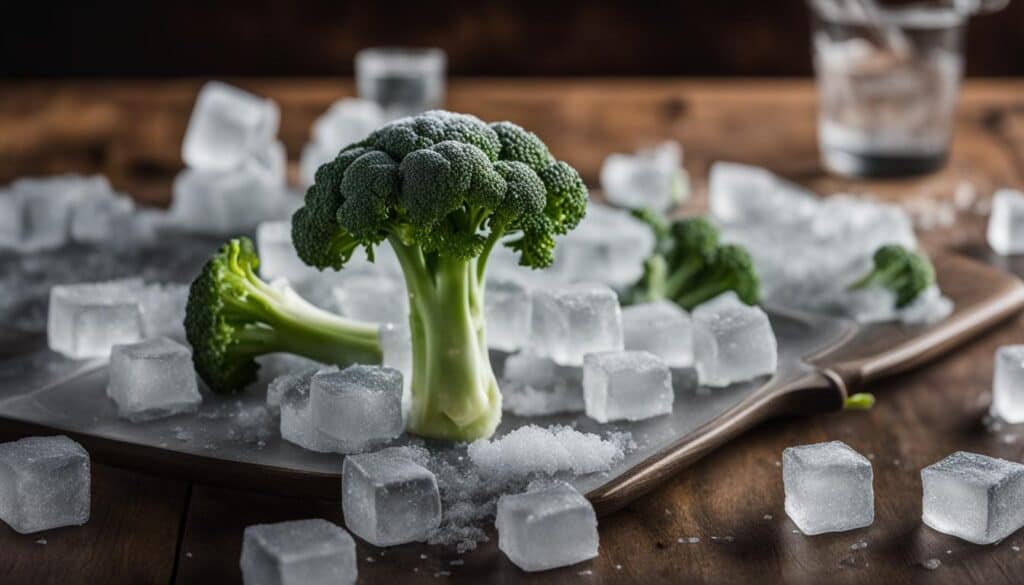Broccoli is a versatile vegetable that is packed with essential vitamins, minerals, and antioxidants. However, it can be challenging to consume it all before it starts to spoil. That’s where freezing comes in.
By properly freezing broccoli, you can extend its shelf life and have a ready-to-use supply whenever you need it. Whether you want to use it in stir-fries, soups, or casseroles, frozen broccoli can be a convenient and nutritious addition to your meals.
In this article, I’ll guide you through the best way to freeze broccoli, including the essential step of blanching. You’ll also learn how to store frozen broccoli properly and discover some delicious recipes that make use of this versatile ingredient.
Ready to reduce waste and enjoy the benefits of freezing broccoli? Let’s get started!
Key Takeaways:
- Freezing broccoli helps you reduce waste and preserve its flavor, texture, and nutrients.
- Blanching broccoli before freezing is essential to retain its color, flavor, and nutritional value.
- By following a step-by-step guide, you can effectively freeze broccoli at home for long-term storage.
- Frozen broccoli can be cooked directly from frozen and used in a variety of recipes.
- Proper storage and timely use will ensure that your frozen broccoli remains fresh and flavorful.
Why You Should Blanch Broccoli Before Freezing
Blanching broccoli before freezing is crucial for preserving its color, flavor, and nutrients. By blanching, we briefly boil the broccoli and then rapidly cool it in ice water. This simple process helps to maintain the quality of the broccoli and prevent it from becoming mushy or losing its nutritional value during freezing.
Blanching works by quickly halting the enzymes that cause the broccoli to break down and affecting its color and texture. It also helps to remove any dirt or bacteria that may be present on the surface of the vegetable. As a result, blanched broccoli retains its vibrant green color, its distinct taste, and its valuable nutritional content even after it has been frozen.
To blanch broccoli, follow these simple steps:
- Start by trimming any woody ends from the broccoli and dividing it into equal-sized florets.
- Bring a pot of water to a rolling boil and add the broccoli florets.
- Allow the broccoli to boil for 2-3 minutes, ensuring that it is still crisp and firm.
- Using a slotted spoon or tongs, transfer the blanched broccoli to a bowl of ice water.
- Let the broccoli cool in the icy water for the same amount of time it was boiled.
- Once cooled, drain the broccoli and pat it dry with a clean kitchen towel.
Now your broccoli is blanched and ready to be frozen!
Blanching broccoli before freezing is a simple yet essential step that ensures the best results when preserving this versatile vegetable. It is worth the extra effort to enjoy the vibrant color, delicious taste, and optimal nutritional benefits of blanched broccoli in your frozen meals.
Next, we’ll delve into the detailed step-by-step guide for freezing broccoli. But before that, take a look at this image that depicts the blanching process:
Step-by-Step Guide to Freezing Broccoli
Freezing broccoli is a simple process that allows you to preserve this nutritious vegetable for later use. Follow these easy steps to freeze broccoli at home effectively:
-
Prepare the broccoli by trimming any woody ends and dividing it into equal-sized florets.
-
Bring a pot of water to a boil and blanch the broccoli for 2-3 minutes. Blanching is an essential step that helps retain the color, flavor, and nutrients of the broccoli.
-
Remove the blanched broccoli from the boiling water using a slotted spoon or tongs, and immediately transfer it to a bowl of ice water to stop the cooking process. This will help maintain the crispness and texture of the broccoli.
-
After the broccoli has cooled in the ice water, drain it thoroughly to remove any excess moisture. You can gently pat it dry with a kitchen towel to ensure it is completely dry.
-
Arrange the broccoli in a single layer on a tray lined with parchment paper to prevent sticking. This allows for quick freezing and easy separation of the florets later on.
-
Place the tray of broccoli in the freezer and let it freeze until solid. This usually takes a few hours, but overnight freezing is ideal.
-
Once the broccoli is frozen, transfer it to a labeled freezer bag or airtight container. Be sure to remove any excess air from the bag or container to prevent freezer burn.
-
Store the labeled bag or container of frozen broccoli in the freezer for up to a year. This allows you to enjoy the convenience of having frozen broccoli readily available whenever you need it.
Cooking with Frozen Broccoli
Frozen broccoli is a versatile ingredient that can be easily incorporated into a variety of recipes, without the need for thawing. Whether you’re looking to add some green to your stews, casseroles, pasta dishes, or even roasted dishes, frozen broccoli is a convenient and nutritious option.
Methods for Cooking Frozen Broccoli
There are different methods you can use to cook frozen broccoli, depending on your preference and the recipe you’re preparing:
- Boiling: Boiling is a quick and easy way to cook frozen broccoli. Simply add the frozen broccoli to a pot of boiling water and cook for a few minutes until tender. Drain and serve.
- Roasting: Roasting frozen broccoli can bring out its natural sweetness and add a delicious caramelized flavor. Toss the frozen broccoli florets with olive oil, salt, and pepper, then spread them out on a baking sheet. Roast in a preheated oven at 425°F for about 20 minutes or until the edges are crispy.
- Pan-frying: Pan-frying frozen broccoli gives it a nice charred flavor and is perfect for stir-fries or as a side dish. Heat some oil in a skillet over medium-high heat, add the frozen broccoli, and cook until it is lightly browned and tender, stirring occasionally.
- Microwaving: If you’re looking for a quick and convenient option, microwaving frozen broccoli is the way to go. Simply place the frozen broccoli in a microwave-safe dish, add a small amount of water, cover with a microwave-safe lid or plastic wrap, and cook on high for a few minutes until tender.
Recipe Idea: Easy Cheesy Broccoli Casserole
If you’re looking for a delicious recipe that showcases the versatility of frozen broccoli, try making an Easy Cheesy Broccoli Casserole. This comforting dish is perfect for a weeknight dinner or as a side dish for a holiday meal.
| Ingredients | Instructions |
|---|---|
|
|
This Easy Cheesy Broccoli Casserole is a crowd-pleasing dish that brings out the natural flavors of frozen broccoli. The combination of melty cheddar cheese, crispy breadcrumbs, and tender broccoli is irresistible. Serve it as a main course or as a side dish alongside your favorite protein.
Next time you have some frozen broccoli on hand, don’t hesitate to get creative in the kitchen. From simple weeknight meals to festive holiday dishes, frozen broccoli is a convenient and nutritious ingredient that can elevate any recipe.
Delicious Recipes Using Frozen Broccoli
Looking for creative and flavorful ways to use frozen broccoli? Look no further! These delicious recipes showcase the versatility of frozen broccoli and will delight your taste buds. Whether you’re in the mood for pasta, soup, or noodles, there’s something here for everyone. Let’s dive in!
1. Broccoli Pesto & Pancetta Pasta
This mouthwatering dish combines the rich flavors of broccoli, pancetta, and pesto to create a satisfying pasta experience. The savory pancetta adds a delightful crunch, while the broccoli and pesto infuse each bite with freshness. It’s a perfect blend of comfort and sophistication.
Ingredients:
- 1 cup frozen broccoli
- 4 ounces pancetta, diced
- 8 ounces pasta of your choice
- 1/4 cup pesto
- Salt and pepper to taste
Instructions:
- Cook the pasta according to package instructions. Drain and set aside.
- In a large skillet, cook the pancetta until crispy. Remove from the pan and set aside.
- In the same skillet, add the frozen broccoli and cook until tender.
- Add the cooked pasta, crispy pancetta, and pesto to the skillet. Toss until well combined.
- Season with salt and pepper to taste.
- Serve hot and enjoy!
2. Broccoli & Pea Soup with Minty Ricotta
Warm up with a comforting bowl of broccoli and pea soup. This nutritious soup combines the sweetness of peas with the earthy goodness of frozen broccoli. The addition of minty ricotta adds a burst of freshness that takes this soup to the next level.
Ingredients:
- 1 cup frozen broccoli
- 1 cup frozen peas
- 1 small onion, diced
- 2 cloves garlic, minced
- 4 cups vegetable broth
- 1/2 cup ricotta cheese
- A handful of fresh mint leaves, chopped
- Salt and pepper to taste
Instructions:
- In a large pot, sauté the onion and garlic until fragrant.
- Add the frozen broccoli, peas, and vegetable broth. Bring to a boil, then reduce heat and simmer for 15 minutes.
- Using an immersion blender or regular blender, puree the soup until smooth.
- In a small bowl, mix the ricotta cheese and chopped mint leaves.
- Season the soup with salt and pepper to taste.
- Serve the soup hot, topped with a dollop of minty ricotta.
3. Spicy Mushroom & Broccoli Noodles
If you’re craving a spicy kick, this noodle dish is for you. The combination of frozen broccoli, shiitake mushrooms, and flavorful spices creates a tantalizing explosion of flavors. It’s quick, easy, and perfect for satisfying your spicy cravings.
Ingredients:
- 1 cup frozen broccoli
- 8 ounces noodles of your choice
- 8 ounces shiitake mushrooms, sliced
- 2 cloves garlic, minced
- 2 tablespoons soy sauce
- 1 tablespoon sriracha sauce
- 1 tablespoon sesame oil
- Green onions for garnish
Instructions:
- Cook the noodles according to package instructions. Drain and set aside.
- In a large skillet, sauté the garlic until fragrant.
- Add the frozen broccoli and shiitake mushrooms. Cook until tender.
- In a small bowl, mix the soy sauce, sriracha sauce, and sesame oil.
- Add the cooked noodles to the skillet and pour the sauce mixture over them. Toss until well coated.
- Garnish with green onions and serve hot.
These recipes are just the beginning – there are countless ways to get creative with frozen broccoli. So go ahead, experiment, and discover your favorite way to cook with frozen broccoli!
| Recipe | Ingredients | Instructions |
|---|---|---|
| Broccoli Pesto & Pancetta Pasta | 1 cup frozen broccoli 4 ounces pancetta, diced 8 ounces pasta of your choice 1/4 cup pesto Salt and pepper to taste |
Cook the pasta according to package instructions. Drain and set aside. In a large skillet, cook the pancetta until crispy. Remove from the pan and set aside. In the same skillet, add the frozen broccoli and cook until tender. Add the cooked pasta, crispy pancetta, and pesto to the skillet. Toss until well combined. Season with salt and pepper to taste. Serve hot and enjoy! |
| Broccoli & Pea Soup with Minty Ricotta | 1 cup frozen broccoli 1 cup frozen peas 1 small onion, diced 2 cloves garlic, minced 4 cups vegetable broth 1/2 cup ricotta cheese A handful of fresh mint leaves, chopped Salt and pepper to taste |
In a large pot, sauté the onion and garlic until fragrant. Add the frozen broccoli, peas, and vegetable broth. Bring to a boil, then reduce heat and simmer for 15 minutes. Using an immersion blender or regular blender, puree the soup until smooth. In a small bowl, mix the ricotta cheese and chopped mint leaves. Season the soup with salt and pepper to taste. Serve the soup hot, topped with a dollop of minty ricotta. |
| Spicy Mushroom & Broccoli Noodles | 1 cup frozen broccoli 8 ounces noodles of your choice 8 ounces shiitake mushrooms, sliced 2 cloves garlic, minced 2 tablespoons soy sauce 1 tablespoon sriracha sauce 1 tablespoon sesame oil Green onions for garnish |
Cook the noodles according to package instructions. Drain and set aside. In a large skillet, sauté the garlic until fragrant. Add the frozen broccoli and shiitake mushrooms. Cook until tender. In a small bowl, mix the soy sauce, sriracha sauce, and sesame oil. Add the cooked noodles to the skillet and pour the sauce mixture over them. Toss until well coated. Garnish with green onions and serve hot. |
Proper Storage and Shelf Life for Frozen Broccoli
When it comes to storing frozen broccoli, proper storage techniques are essential to maintain its quality and extend its shelf life. Here are some tips on how to store frozen broccoli effectively:
- Transfer: Once you have frozen the broccoli on a tray, transfer it to a labeled freezer bag or airtight container. This step is crucial for preventing freezer burn and maintaining the freshness of the broccoli.
- Remove Air: To minimize the risk of freezer burn, make sure to remove any excess air from the freezer bag or airtight container before sealing it. This will help preserve the taste, texture, and nutritional value of the frozen broccoli.
- Label and Date: It’s important to label the freezer bag or airtight container with the date of freezing. This will help you keep track of the storage time and ensure that you use the frozen broccoli within the recommended timeframe for optimal quality.
Frozen broccoli can be stored in the freezer for up to a year, but it is advisable to use it within 6-8 months for the best flavor and texture. By following these storage guidelines, you can enjoy the convenience and nutritional benefits of frozen broccoli for an extended period.
Shelf Life of Frozen Broccoli
The shelf life of frozen broccoli can vary depending on the storage conditions and the quality of the broccoli at the time of freezing. While frozen broccoli can technically be stored for up to a year, it is essential to consider the optimal storage timeframe for maintaining its taste and texture.
The general guideline for the shelf life of frozen broccoli is as follows:
| Storage Time | Quality of Frozen Broccoli |
|---|---|
| Up to 6 months | Best quality with minimal loss of flavor and nutrients |
| 6-8 months | Good quality with slightly reduced flavor and texture |
| 8-12 months | Potential loss of flavor, texture, and nutritional value |
It’s important to note that while frozen broccoli may still be safe to consume after the recommended storage timeframe, its quality may have diminished. To enjoy the best taste and texture, it is advisable to use frozen broccoli within the suggested shelf life.
Proper storage and timely use are key to maintaining the freshness and flavor of frozen broccoli. By following these guidelines, you can ensure that your frozen broccoli remains a delicious and nutritious addition to your meals for an extended period.
The Benefits of Freezing Broccoli
Freezing broccoli offers several benefits, including:
- Reduction of waste: Freezing allows you to preserve excess broccoli and prevent it from going to waste.
- Convenient and time-saving: Having frozen broccoli readily available can save you time in meal preparation, as there is no need to defrost it before cooking.
- Retention of nutrients: Properly frozen broccoli retains most of its nutritional value, allowing you to enjoy its health benefits even after freezing.
By freezing broccoli, you not only minimize waste but also enjoy the convenience of having it on hand whenever you need it, without the hassle of defrosting. This preservation method also ensures that the valuable nutrients present in broccoli are preserved, making it a healthy addition to your meals even after freezing.
I always freeze broccoli to avoid wasting any leftovers and to have a quick and nutritious option for meals. It’s such a time-saver and the nutritional benefits are still there even after freezing.
Benefits of Freezing Broccoli
| Benefits | Description |
|---|---|
| Reduction of waste | Prevents excess broccoli from going to waste. |
| Convenient and time-saving | Eliminates the need for defrosting, saving meal preparation time. |
| Retention of nutrients | Preserves the nutritional value of broccoli for continued health benefits. |
Tips for Freezing Broccoli
Freezing broccoli is a great way to preserve its freshness and ensure that you always have this nutritious vegetable on hand. To help you freeze broccoli effectively and maximize its quality, here are some helpful tips:
-
Choose freshly harvested broccoli for freezing to maximize quality.
-
Use the blanching method to preserve the color, flavor, and nutrients of the broccoli.
-
After blanching, spread the broccoli in a single layer on a tray for quick freezing.
-
Properly label and date your frozen broccoli to keep track of its storage time.
-
Use the frozen broccoli within the recommended storage timeframe for optimal quality.
By following these tips, you can ensure that your frozen broccoli maintains its taste, texture, and nutritional value. Now, let’s take a look at how these tips can be applied in practice through a step-by-step guide to freezing broccoli.
Conclusion
Freezing broccoli is a simple and effective way to preserve this versatile vegetable for long-term storage. By following the proper steps, including blanching before freezing, you can maintain the flavor, texture, and nutrients of the broccoli.
With the convenience of having frozen broccoli on hand, you can easily incorporate it into various recipes and enjoy its health benefits throughout the year. Whether you add it to soups, stir-fries, or casseroles, frozen broccoli retains its vibrant color and crispness, providing a delicious and nutritious addition to your meals.
So don’t let your fresh broccoli go to waste! Take advantage of the freezing method to extend its shelf life and have a readily available supply of this nutritious vegetable. Freeze your broccoli properly and enjoy its goodness whenever you need it.








Leave a Reply